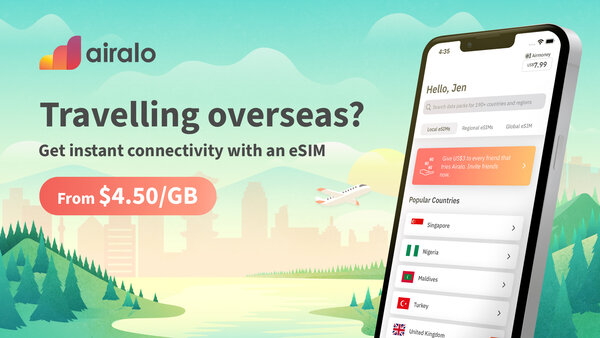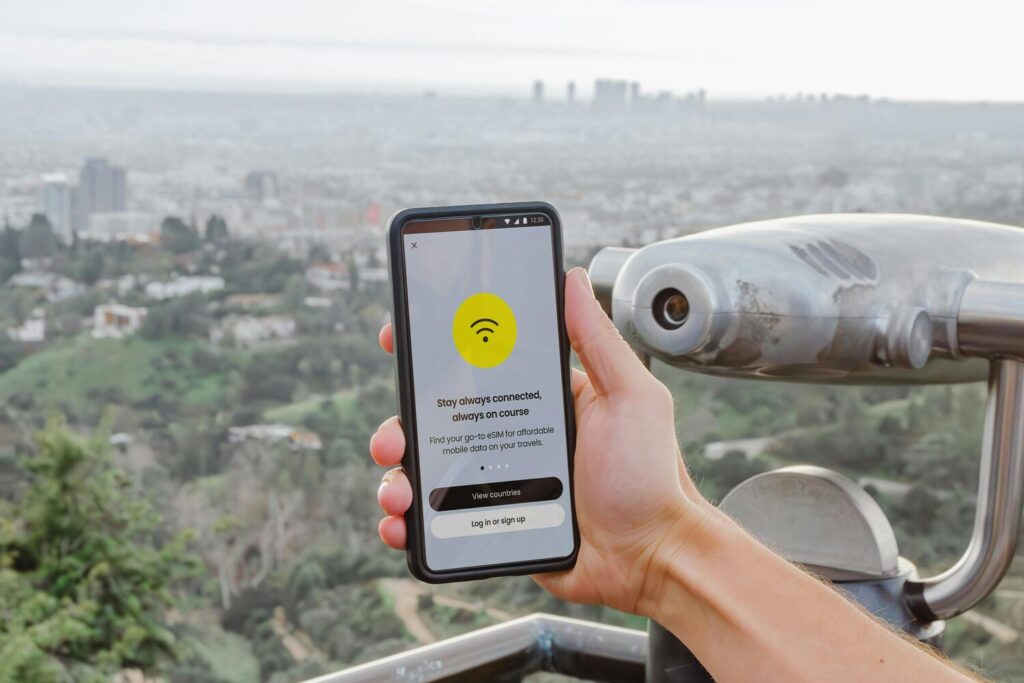
TruPhone Review: The Best eSIM for Travel in 2025
If you’re constantly hopping between countries for work or travel, then you will already know that it can be difficult to stay connected while abroad. Or at least it was, until eSIMs were invented.
Short for the term “embedded SIM”, an eSIM is a digital SIM card that is built directly into your device, which therefore takes away the need for a physical SIM card. Overall, there are dozens of providers of this technology out there, with TruPhone being one of the more established players in the marketplace.
Since launching almost 20 years ago, TruPhone has built a solid reputation for itself by offering flexible, contract-free mobile data that works in over 160 countries.
The brand is also known for the straightforward setup of its service, its competitive pricing, and for offering decent coverage in major travel destinations. Some of their plans even come with unlimited data, which makes it a convenient pick for heavier users who rely on hotspotting or constant connectivity while abroad.
In this review, we’ll break down everything you need to know about using TruPhone’s service, covering everything from pricing and coverage to internet speed and customer support. We’ll also tell you how it compares to other eSIM providers to help you decide whether it’s the right fit for your needs.
Overview of TruPhone eSIM
Now operating under the brand 1GLOBAL, TruPhone is a UK-based telecommunications company that was founded in 2006 by Alexander Straub and James Tagg.
Headquartered in London, it originally specialised in VoIP before turning its attention to the eSIM market. The company was acquired by TP Global Operations Limited in 2023 and then rebranded, although its eSIM services still operate under the TruPhone label in most international markets.
The company has a good standing in the industry and, over the years, has received accolades like Best MVNO at the Telecoms.com Awards and a shortlist at the GSMA Global Mobile Awards. Such recognitions demonstrate how reliable and innovative experts within the mobile technology industry view them to be.
TruPhone competes well with major eSIM providers like FlexiRoam, Airalo, Holafly, Ubigi, and BNESIM. Its main strengths are that it provides its customers with truly global coverage rather than just regional or country-specific plans.
They have a particularly strong presence in the business and enterprise travel markets, where reliability and broad reach are of vital importance to users.
Key Features at a Glance:
- Their coverage extends to over 160+ countries
- They provide customers with access to 4G LTE predominantly and 5G (where available)
- Pricing is competitive for global data and sits mid-tier when compared to regional-focused competitors
- Their app has a clean interface for managing plans
- ESIM activation is instant via the My Truphone app
Coverage & Network Reliability
As mentioned, TruPhone’s eSIM solution provides customers with coverage in over 160+ countries around the world. This makes it a good option for travelers who want to visit multiple regions without enduring the hassle of having to switch SIM cards.
Typically, in Europe, you will find the connection is consistently strong. This is especially true in western European countries like the UK, Ireland, France, Netherlands, Belgium, Italy, and Spain. In those nations, users can generally enjoy fast speeds and reliable roaming, largely thanks to the company’s partnerships with top carriers like Vodafone, Orange, and Telefónica.
In North America, TruPhone connects users via AT&T and T-Mobile, so within the USA and Canada, users should receive good coverage in urban and suburban areas. However, given the size of the country, you may experience weaker signals in more remote and rural zones.
Overall, Asia can be a bit of hit or miss because high-speed 4G and occasional 5G are available in places like Singapore, Japan, and South Korea. However, service is less reliable in India and parts of China, where local restrictions, less developed infrastructure or weaker partnerships can negatively affect performance.
Similarly, in South America and Africa, the quality depends heavily on location. Users in most major cities on these continents, such as São Paulo in Brazil and Cape Town in South Africa, enjoy decent speeds. However, again, connectivity in rural regions isn’t as strong.
Across Australia and New Zealand, coverage is pretty good in all urban areas, but in regional destinations and other countries in Oceania, it might not be as good.
Data Plans & Pricing
TruPhone offers a range of prepaid data plans that are designed to suit the different needs of its customer base. This ranges from those enjoying a quick city break to others planning an extended stint abroad.
Generally, their plans are divided into three sections: local, regional and global. Local plans are best for travelers who intend to stay in one country, such as Australia, Scotland, or Peru. On the other hand, regional plans are ideal for those planning on taking a multi-country trip within a continent, like Europe.
Global plans are tailor-made for digital nomads or business travelers who are crossing continents and spend large periods of time overseas.
Plans vary in cost depending on the type you get and where you want to use it. Typically, they are valid for anywhere between 1 day to 30 days and come with between 1GB and 100 GB of data.
The good thing about TruPhone’s data plans is that there are no known hidden fees. However, it’s worth noting that data expires after the plan’s validity period, and there are no rollover options. Additionally, hotspot and tethering are allowed on most plans.
Internet Speed & Network Performance
TruPhone users generally report stable 4G LTE performance across most countries, while there is limited but growing 5G availability in select urban areas. Speed tests show that the service averages between 20–80 Mbps, depending on the country and local carrier partnerships.
These speeds mean their eSIM service is ideal for streaming, video conferencing, and remote work. At the same time, latency is acceptable for most tasks, but some users report slightly higher ping times due to international routing through European servers. That said, for everyday use, such as browsing, calls, and HD streaming then TruPhone holds up well.
Overall, users haven’t widely reported throttling, but as with many providers, speeds may drop during peak times or after using large amounts of data.
Ease of Use & Setup Process
One of TruPhone’s strongest points is just how easy it is to purchase, install, and activate a plan.
Here is an overview of how it works:
- Download the My Truphone app from your app store.
- Select your destination and data plan.
- Pay securely via the app.
- Instantly activate the eSIM (without relying on a QR code).
The app itself is sleek and intuitive, and it allows you to check your balance, add data, or switch plans with ease. It’s especially helpful for users who are planning multiple trips or working across different geographic regions.
TruPhone also offers 24/7 customer support, mostly via email and in-app chat, which some of their competitors don’t. Response times are usually quick, and the support team is helpful with setup issues, concerns about your account, or any questions about coverage you may have.
Pros & Cons of TruPhone eSIM
Like with most of their competitors in the eSIM market, there are some things TruPhone do very well and other areas in which they can lift their game.
Outlined below is a brief overview of some of its main pros and cons.
Pros:
Probably TruPhone’s biggest selling points are that it offers global coverage in over 160 countries, has a fast setup, and is a very user-friendly app.
This makes it ideal for digital nomads and business travelers who need reliable data without juggling physical SIM cards. Their flexible pay-as-you-go and regional plans also cater to a wide range of travel styles.
Cons:
On the flip side, their pricing can be higher than competitors like Airalo or Nomad, especially for global plans. In addition, their coverage and speeds may vary in rural or developing regions, and 5G access isn’t guaranteed everywhere.
During peak travel seasons, some users have also reported longer support response times. So, while understandable, it’s something to be aware of.
How Does TruPhone Compare to Other eSIM Providers?
TruPhone stands up pretty well when compared to other competitors.
Some, like Airalo, might offer cheaper regional plans, while others, like Holafly, might present more unlimited data options. There are also companies, such as Nomad, that position themselves as being more budget-friendly.
But overall, TruPhone has steadily built a strong reputation, well-established global infrastructure, and good quality of service, which, when all things are considered, make it an attractive option – especially for business travellers and frequent flyers.
Is TruPhone Worth It?
If you want to be able to depend on reliable global coverage, through a service that is easy to set up and offers a decent user experience, then TruPhone is absolutely worth considering.
It is not the cheapest eSIM on the market, but it does deliver strong value for money through its trusted reputation, broad international support, and simple app interface. For most digital nomads, remote workers, and business travelers, it will do a great job.








Responses